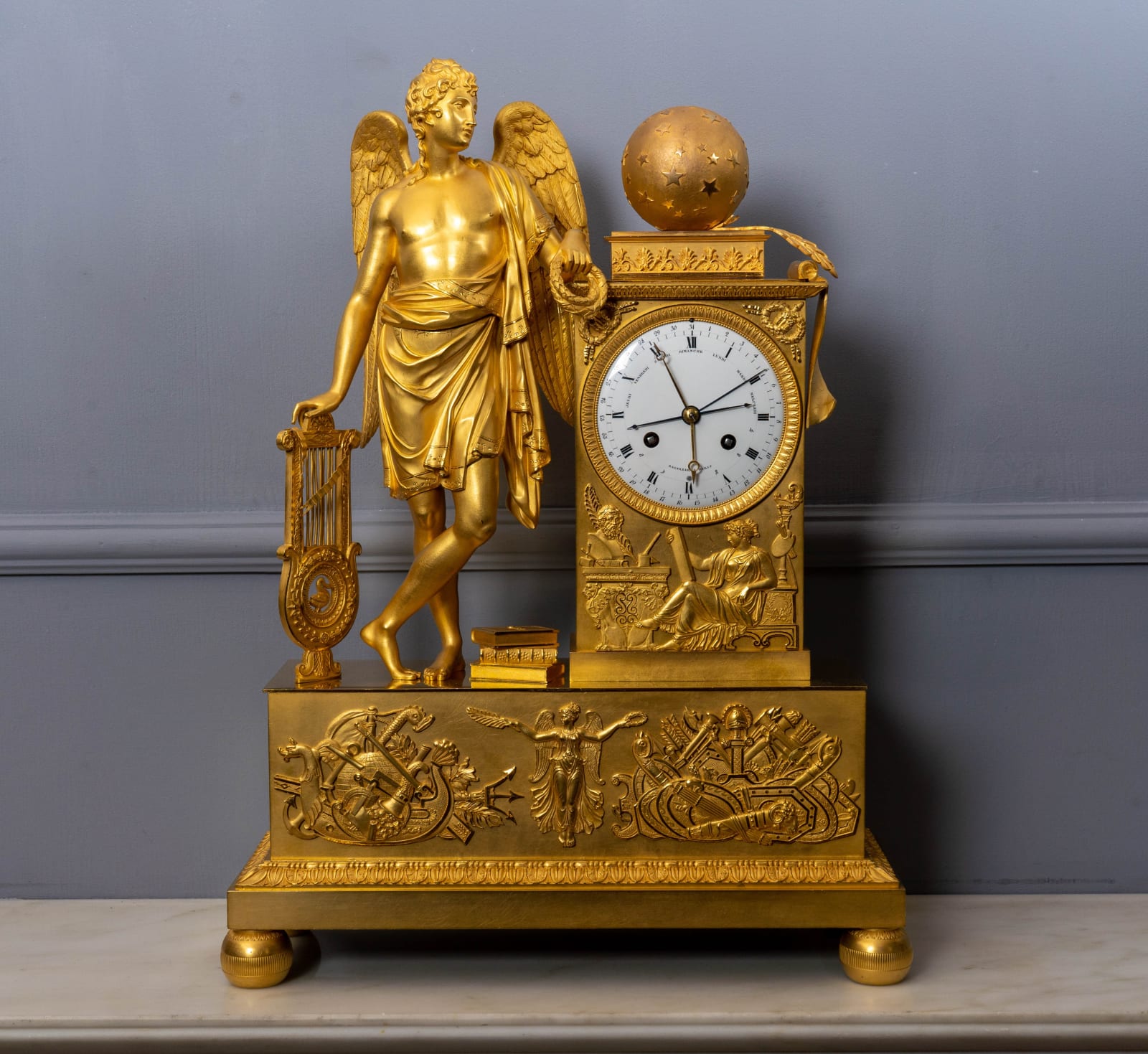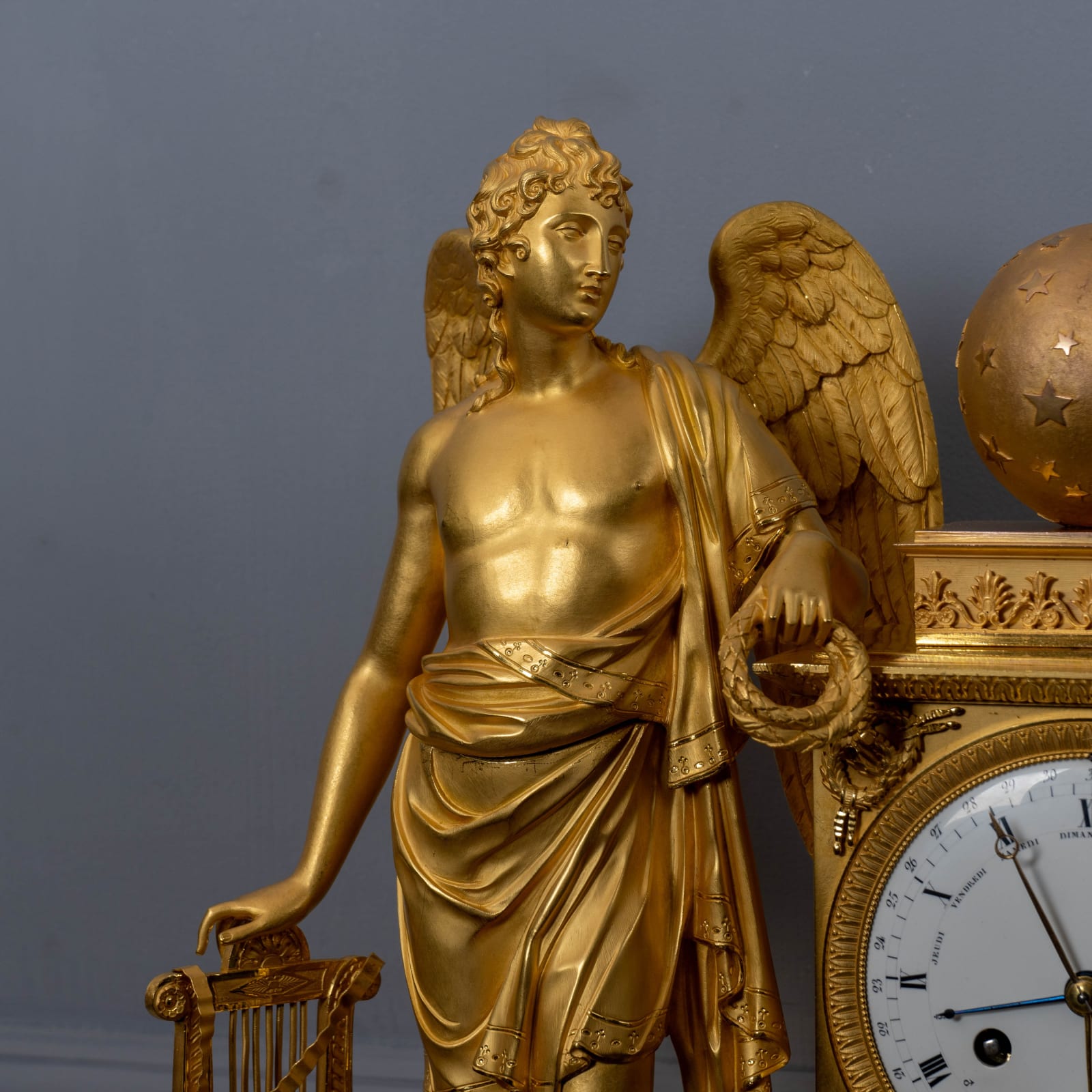Baltazar
Further images
Literature
Literature: Cedric Jagger, “Royal Clocks,” 1983, p. 149, pl. 203, illustrating a comparable clock, known as the Artium Genioclock with case by Pierre-Philippe Thomire, in the British Royal Collection.
A very fine and rare Empire gilt bronze mantel clock signed on the white enamel dial Baltazar à Paris and housed in a magnificent case attributed to Pierre-Philippe Thomire. The dial with Roman numerals for the hours, indications for the minutes, an outer calendar ring with Arabic numerals for the 31 days of the month, and an inner ring with the names of the days of the week between 9 & 3 o’clock and their corresponding symbols between 3 & 9 o’clock, with a fine pair of gilt brass Breguet hands for the hours and minutes and blued steel pointers for the calendar indications. The movement with anchor escapement, silk thread suspension, striking on the hour and half hour on a single bell, with outside count wheel. The case with a stiff-leaf beaded dial bezel, set within an upright plinth, surmounted by a smaller anthemion mounted plinth, above which is a star-studded globe, with a plume and scroll to one side and to the left, the standing winged figure of the Genius of the Arts, represented by Apollo, who looks toward the globe. In his left hand he holds a wreath, his right hand rests upon his lyre, while beside his feet are three books, of which the upper one is inscribed ‘Ovide’. The dial plinth mounted in the upper corners with ribbon-tied wreaths and a central torch. Below the dial is a beautiful classical maiden representing Rhetoric who, wearing a loose tunic, sits upon a stool and holds a tablet in her right hand. Behind her, to the right, is a lamp of which the shaft is mounted by an artist’s palette and paint brushes. To the left of Rhetoric is a pedestal with outward facing lion supports, upon which is classical male bust upon a book, beside which is a mallet, chisel and other sculptor’s tools. The rectangular base lavishly mounted, showing at centre a classical winged female in diaphanous drapery holding a wreath in her left hand and a flowering branch in the other. To either side are trophies, the one to the right is a military trophy that includes shields, axes, arrows, a flaming torch, a scabbard and a central sword surmounted by a helmet. To the left of the base is a trophy representing travel and exploration, showing a boat with a mythical beast at its bow and foliate tail at its stern, the boat with a billowing sail, surrounded by an anchor, Neptune’s trident, a ruler, an oar and sea monster, and laden with a globe, a cornucopia filled with fruit, a compass, sextant and other navigational tools. The base with a stepped foliate border above bun feet
Paris, date circa 1810
Height 52 cm, width 38 cm, depth 14 cm.
Literature: Cedric Jagger, “Royal Clocks,” 1983, p. 149, pl. 203, illustrating a comparable clock, known as the Artium Genioclock with case by Pierre-Philippe Thomire, in the British Royal Collection.
Whilst rare, this superb clock representing the Liberal Arts, compares closely with one housed in the Salle du Conseil d’État at Hôtel de Bourvallais, Paris, the seat of the Ministère de la Justice, as well as another in the Richard Redding collection, housing a movement by Jean-Nicolas Picnot (fl. 1785 d post 1821). The latter two differ slightly from the present example, notably the mounts on the plinth and base; Apollo, as the Genius of the Arts, does not have a lyre or books at his feet and also his clothing is also simpler. The case model can also be compared with the Artium Genio clock, made by the esteemed Empire bronzier Pierre-Philippe Thomire (1751-1843), of which Thomire’s original watercolour design of c. 1800-10 and his finished clock are in the British Royal Collection. The latter was purchased in 1813 by George IV, when Regent, and was displayed in the Throne Room at Carlton House, London but in 1828 was moved to Windsor Castle. As here, the British Royal clock represents the Genius of the Arts but shows the winged figure standing to the right of an arched plinth that, likewise, shows below the dial the same female figure holding a tablet. Again, as here, there are military trophies as well as a variety of attributes of the arts. As noted the clock portrays the Liberal Arts that include Astronomy, represented by the globe; Geometry symbolised by various measuring instruments; Rhetoric, as shown by the seated female figure and Logic, on the base, who holds up a wreath and flowering branch. Music is represented by Apollo’s lyre while the visual arts are represented by the sculptor and painters’ tools. Furthermore, the books, of which one is inscribed ‘Ovide’ (referring to the renowned classical poet) denotes literature, while the military trophies remind us of the strength of the arts.
Given the extreme high quality of the case and the comparison with the one made by Thomire, there are strong grounds to attribute the present work to the same esteemed maker. Pierre-Philippe Thomire is regarded as one of history’s finest fondeur-ciseleurs. He enjoyed the patronage of the Emperor Napoleon and his family but also Louis XVI, Louis XVIII as well as foreign monarchy and aristocracy. Born into a family of ciseleurs, Thomire began working with the renowned bronzier Pierre Gouthière as well as Jean-Louis Prieur ciseleur-doreur du roi, before opening up his own workshop in 1776. Famed for his production of finely chased gilt bronze objets de luxe, of which a large quantity was commissioned by the royal household, Thomire frequently collaborated with the marchands-mercier, such as Simon-Philippe Poirier and his successor Dominique Daguerre. In addition, Thomire supplied finely chased mounts to leading ébénistes of his day such as Guillaume Benneman and Adam Weisweiler. Thomire also helped establish his name when working at the Sèvres Porcelain Manufactory, firstly as an assistant to its artistic director Jean-Claude Duplessis in making the factory’s mounts and then, following the latter’s death in 1783, he took over Duplessis’s job and in this capacity supplied all the gilt bronze mounts for the factory’s porcelain. His post-Revolutionary success somewhat eclipsed his fame during Louis XVI’s reign. For instance, in 1806 he became the first bronzier to win a gold medal at the Exposition des Produits de l’Industrie and he went on to win another gold medal in 1809, in which year he also became ciseleur de l’Empereur.
In response to growing demand Thomire became an associate and then in 1804 purchased the extensive business owned by Martin-Eloi Lignereux, the famous marchand-mercier, formerly associated with Daguerre. Soon his newly named company Thomire-Duterme et Cie was employing a work force of about eight hundred; it had a Paris workshop at rue Boucherat and a showroom at rue Taitbout, from where Thomire retailed a large range of decorative objects inspired by antiquity which, in addition to clock cases, included surtouts and centrepieces, candelabra and monumental Greek and Roman style urns and vases. Like many Parisian trades, the firm encountered financial difficulties owing to the continuing Napoleonic Wars. Soon after 1815 the partnership with Duterme was dissolved and under its new style, Thomire et Cie, it thrived once more under the restored Bourbons. 1823 saw Thomire winning a gold medal for sculpture in Paris as well as his retirement from the firm, though he continued to produce sculptures and regularly exhibited at the Paris Salon up until 1834. His business was continued by his two sons-in-law and then his grandsons up until 1852.
The clock’s movement was made by Baltazar à Paris. He descended from the renowned horological Balthazar family, who as here often signed their dials Baltazar. According to Tardy, by 1800 Balt[h]azar à Paris was established at Pont Saint-Michel, while other evidence shows that by 1804, the mécanicien-horloger, Monsieur Balthazar, was working from Rue de la Calandre, Paris. Tardy notes that the latter address was where the concern, known as Balt[h]azar Fils, continued up until at least 1830.







